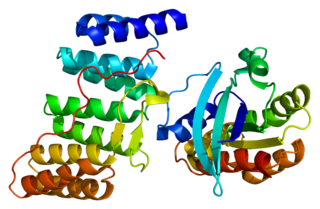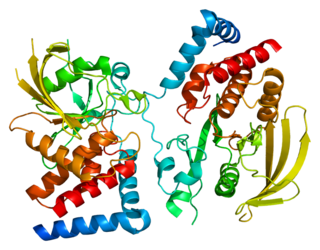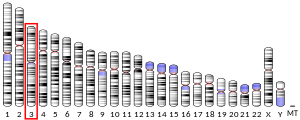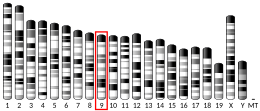
Ras association domain-containing protein 1 is a protein that in humans is encoded by the RASSF1 gene.

DnaJ homolog subfamily A member 3, mitochondrial, also known as Tumorous imaginal disc 1 (TID1), is a protein that in humans is encoded by the DNAJA3 gene on chromosome 16. This protein belongs to the DNAJ/Hsp40 protein family, which is known for binding and activating Hsp70 chaperone proteins to perform protein folding, degradation, and complex assembly. As a mitochondrial protein, it is involved in maintaining membrane potential and mitochondrial DNA (mtDNA) integrity, as well as cellular processes such as cell movement, growth, and death. Furthermore, it is associated with a broad range of diseases, including neurodegenerative diseases, inflammatory diseases, and cancers.

Ras-related C3 botulinum toxin substrate 3 (Rac3) is a G protein that in humans is encoded by the RAC3 gene. It is an important component of intracellular signalling pathways. Rac3 is a member of the Rac subfamily of the Rho family of small G proteins. Members of this superfamily appear to regulate a diverse array of cellular events, including the control of cell growth, cytoskeletal reorganization, and the activation of protein kinases.

Probable G-protein coupled receptor 124 is a protein that in humans is encoded by the GPR124 gene. It is a member of the adhesion-GPCR family of receptors. Family members are characterized by an extended extracellular region with a variable number of protein domains coupled to a TM7 domain via a domain known as the GPCR-Autoproteolysis INducing (GAIN) domain.

Hsc70-interacting protein also known as suppression of tumorigenicity 13 (ST13) is a protein that in humans is encoded by the ST13 gene.

Ras association domain-containing protein 5 is a protein that in humans is encoded by the RASSF5 or F5 gene.

Achaete-scute homolog 1 is a protein that in humans is encoded by the ASCL1 gene. Because it was discovered subsequent to studies on its homolog in Drosophila, the Achaete-scute complex, it was originally named MASH-1 for mammalian achaete scute homolog-1.

Retinoic acid receptor responder protein 3 is a protein that in humans is encoded by the RARRES3 gene.

OX-2 membrane glycoprotein, also named CD200 is a human protein encoded by the CD200 gene. In humans, the CD200 gene is located on chromosome 3 in proximity to genes encoding the other B7 proteins CD80/CD86. In mice, the CD200 gene is located on chromosome 16.

Ras association domain-containing protein 2 is a protein that in humans is encoded by the RASSF2 gene.

Large tumor suppressor kinase 2 (LATS2) is an enzyme that in humans is encoded by the LATS2 gene.

Receptor-type tyrosine-protein phosphatase gamma is an enzyme that in humans is encoded by the PTPRG gene.

Epithelial membrane protein 3 (EMP3) is a trans-membrane signaling molecule that is encoded by the myelin-related gene EMP3. EMP3 is a member of the peripheral myelin protein gene family 22-kDa (PMP22), which is mainly responsible for the formation of the sheath of compact myelin. Although the detailed functions and mechanisms of EMP3 still remain unclear, it is suggested that EMP3 is possibly epigenetically linked to certain carcinomas.

Copine-1 is a protein that in humans is encoded by the CPNE1 gene.

Tyrosine-protein kinase-like 7 also known as colon carcinoma kinase 4 (CCK4) is a receptor tyrosine kinase that in humans is encoded by the PTK7 gene.

CKLF-like MARVEL transmembrane domain-containing protein 2, previously termed chemokine-like factor superfamily 2, is a member of the CKLF-like MARVEL transmembrane domain-containing family (CMTM) of proteins. In humans, it is encoded by the CMTM2 gene located in band 22 on the long arm of chromosome 16. CMTM2 protein is expressed in the bone marrow and various circulating blood cells. It is also highly expressed in testicular tissues: The CMTM2 gene and CMTM2 protein, it is suggested, may play an important role in testicular development.

Mitochondrial tumor suppressor 1 (MTSG1) or Microtubule-Associated Scaffold Protein 1 (MTUS1) is a candidate tumor suppressor protein encoded by the MTUS1 gene in humans. Expression levels of MTUS1 was reported to be lost in various types of human malignancies such as colon, ovarian, head-and-neck, pancreas, breast cancers, bladder, gastric, and lung cancers.

Transcription factor AP-2 gamma also known as AP2-gamma is a protein that in humans is encoded by the TFAP2C gene. AP2-gamma is a member of the activating protein 2 family of transcription factors.

Patched 2 is a protein that in humans is encoded by the PTCH2 gene.

V-domain Ig suppressor of T cell activation (VISTA) is a type I transmembrane protein that functions as an immune checkpoint and is encoded by the VSIR gene.



















